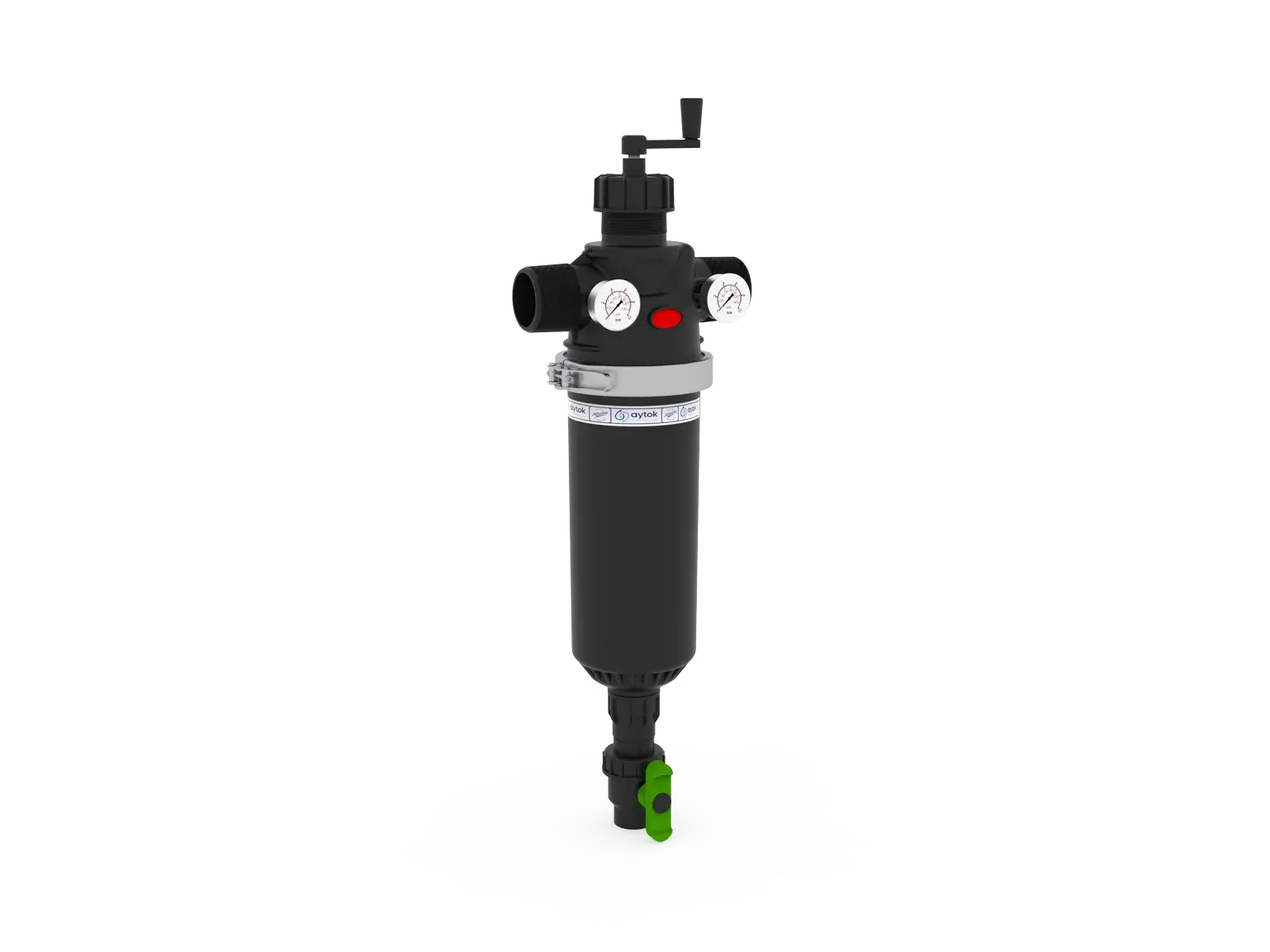| Body Material | PA6GFR30 |
| Cartridge Material | SS304L, PA6GFR30 |
| Maximum Working Pressure | 8 bar ; 116 Psi |
| Minimum Working Pressure | 1 bar ; 14.5 Psi |
| Maximum Working Temperature | 60 °C ; 140°F |
| Control System | Semi Automatic Control |
| Filtration Sensitivity | 20-200 μ (micron) |
Ürünlerimiz
water_drop Irrigation
Uygulama Alanları
water_drop IRRIGATION
Filter Türleri
Media Center

Cleaning Process
The manual flushing process is initiated by opening the filter’s flush valve and rotating the cleaning handle at a constant speed. This rotation moves a set of internal nozzles across the screen surface. The open valve creates a localized pressure drop, generating a high-velocity suction effect through the nozzles that vacuums contaminants off the screen and discharges them. The cleaning cycle consists of two passes: a primary pass as the handle is turned to its limit, and a secondary pass as it is rotated back to its home position. The process is completed by closing the flush valve.
Working Principle
Water enters the filter and passes through the fine screen element. During operation, contaminants gradually accumulate on the inner surface of the screen. This buildup restricts water flow, creating a pressure differential between the filter’s inlet and outlet. Manual cleaning is required when this pressure differential reaches 0.7 bar.
Send us a message
Fill out the form below to contact us.
PV & PVS Series - Plastic Semi-Automatic Screen Filters (Single Body)
GENERAL FEATURES
| Body Material | PA6GFR30 |
| Cartridge Material | SS304L, PA6GFR30 |
| Maximum Working Pressure | 8 bar ; 116 Psi |
| Minimum Working Pressure | 1 bar ; 14.5 Psi |
| Maximum Working Temperature | 60 °C ; 140°F |
| Control System | Semi Automatic Control |
| Filtration Sensitivity | 20-200 μ (micron) |
ADVANTAGES

Cleaning Process
The manual flushing process is initiated by opening the filter’s flush valve and rotating the cleaning handle at a constant speed. This rotation moves a set of internal nozzles across the screen surface. The open valve creates a localized pressure drop, generating a high-velocity suction effect through the nozzles that vacuums contaminants off the screen and discharges them. The cleaning cycle consists of two passes: a primary pass as the handle is turned to its limit, and a secondary pass as it is rotated back to its home position. The process is completed by closing the flush valve.
Working Principle
Water enters the filter and passes through the fine screen element. During operation, contaminants gradually accumulate on the inner surface of the screen. This buildup restricts water flow, creating a pressure differential between the filter’s inlet and outlet. Manual cleaning is required when this pressure differential reaches 0.7 bar.
Send us a message
Fill out the form below to contact us.
PV & PVS Series - Plastic Semi-Automatic Screen Filters (Single Body)
ADVANTAGES
Engineered for Continuous Flow
Aytok semi-automatic filters are built to ensure your operations never stop, delivering an uninterrupted supply of clean water even during cleaning cycles. Their smart design uses a pressure differential system to alert the user when a manual cleaning cycle is needed. This simple user-activated flush efficiently purges all contaminants without halting filtration, guaranteeing trouble-free performance and delivering constant reliability when it matters most.
GENERAL FEATURES
| Body Material | PA6GFR30 |
| Cartridge Material | SS304L, PA6GFR30 |
| Maximum Working Pressure | 8 bar ; 116 Psi |
| Minimum Working Pressure | 1 bar ; 14.5 Psi |
| Maximum Working Temperature | 60 °C ; 140°F |
| Control System | Semi Automatic Control |
| Filtration Sensitivity | 20-200 μ (micron) |
Ürün Detayı

PV & PVS Series - Plastic Semi-Automatic Screen Filters (Single Body)
GENERAL FEATURES
Cleaning Process
The manual flushing process is initiated by opening the filter’s flush valve and rotating the cleaning handle at a constant speed. This rotation moves a set of internal nozzles across the screen surface. The open valve creates a localized pressure drop, generating a high-velocity suction effect through the nozzles that vacuums contaminants off the screen and discharges them. The cleaning cycle consists of two passes: a primary pass as the handle is turned to its limit, and a secondary pass as it is rotated back to its home position. The process is completed by closing the flush valve.
Working Principle
Water enters the filter and passes through the fine screen element. During operation, contaminants gradually accumulate on the inner surface of the screen. This buildup restricts water flow, creating a pressure differential between the filter’s inlet and outlet. Manual cleaning is required when this pressure differential reaches 0.7 bar.
ADVANTAGES
Powerful Filtration, Smarter Design.
Engineered for Continuous Flow
Aytok semi-automatic filters are built to ensure your operations never stop, delivering an uninterrupted supply of clean water even during cleaning cycles. Their smart design uses a pressure differential system to alert the user when a manual cleaning cycle is needed. This simple user-activated flush efficiently purges all contaminants without halting filtration, guaranteeing trouble-free performance and delivering constant reliability when it matters most.
